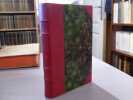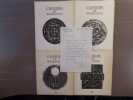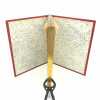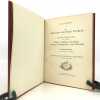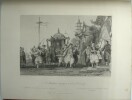-
Type
Any type (2)
Art print (7)
Book (31382)
Disk (1)
Drawings (7)
Engraving (9)
Magazine (125)
Old papers (1)
Photographs (14)
Posters (4)
-
Latest
Last 24h (2)
Last 3 days (7)
Last month (399)
Last week (50)
-
Language
Dutch (1)
English (52)
French (31455)
German (6)
Italian (18)
Portuguese (9)
Spanish (11)
-
Century
16th (15)
17th (56)
18th (213)
19th (1577)
20th (9590)
21st (1706)
-
Countries
Belgium (9489)
Brazil (7)
Canada (108)
China (1)
Côte d'Ivoire (66)
Denmark (218)
France (18555)
Germany (1)
Greece (1)
Italy (37)
Switzerland (3069)
-
Syndicate
ALAC (99)
CLAM (41)
CLAQ (94)
CNE (3)
ILAB (10918)
NVVA (1171)
SLACES (1171)
SLAM (8373)
SNCAO (9)
MANUEL D'HISTOIRE LOCALE. Guide pour la rédaction des Monographies historiques. Contenant plusieurs indications spéciales à la Provence.
Aubanel Frères, Libraires-Editeurs Avignon 1912 In-8 ( 230 X 145 mm ) de XVIII-394 pages, demi-chagrin grenat à coins, dos à nerfs janséniste muet, couverture conservée. llustrations dans et hors-texte. EDITION ORIGINALE. Bel exemplaire.Des manuscrits utiles à l'historien des localités de Provence ( 12 pp ). La religion païenne en Provence d'après les inscriptions. La religion en Provence au Ier siècle avant l'ère chrétienne.Monnaies provençales antérieures au moyen-âge, époque médiévale. Numismatique provençale au moyen-âge. Droit administratif en Provence - Géographie ancienne de la Provence - Administration ecclésiastique. Administration de la province ( avant le XIIe siècle ) - Droit administratif en Provence du XIIe au XVIe siècle. ( 34 pp ). Sources imprimées de l'histoire de Provence ( 60 pp ).
CAHIERS DE BOURGOGNE. 4 volumes ( Tomes I à IV ).
Edition Association DesTrois Mondes La Roche-en-Brenil 1981-1985 4 volumes in-8 carré ( 220 X 180 mm, brochés sous couvertures illustrées. Belle série en parfait état enrichie d'une lettre autographe signée de Francis ALLIOT.- Tome I. Juillet 1981. 41 pages. L'Abbé Nicolas Boon. Temple d'Ezéchiel. Règle de St Benoit et homme de métier. Proposition pour cathédrale de Nevers.- Tome II. 1982. 57 pages. Boon, Formé de poussière. Giriat, Ontologie du métier. Vaillant, Homme de métier et sa marelle. Célerier, Réalité ontologique du corps.- Tome III. 1983.62 pages. Vaillant, Pour un centre d'études de la tradition occidentale. Giriat, Saint Cyr et Sainte Julitte. Le songe de l'empereur. Un enseignement un dessein. Vaillant, Mézières à Nevers, le sanglier.- Tome IV. 1985. 36 pages. Plan de la cathédrale de Nevers par Giriat. Liminaire. Giriat, Art sacré. Célérier, Désintégration-Réintégration. Vailllant, Autorité et pouvoir.
Allison Atieff, Bryan Burkhart, Adrienne Arieff...
Reference : RO20275447
(2008)
ISBN : 3836501902
Spa - Asia, europe, caribbean, africa & middle east, north american oceania, mexico & south america - 25th anniversary
TASCHEN. 2008. In-8. Relié. Bon état, Couv. convenable, Dos satisfaisant, Intérieur frais. 351 PAGES - Nombreuses planches photos en couleur - Jaquette correcte, en état d'usage. Avec Jaquette. . . Classification Dewey : 720-Architecture
Allison Atieff, Bryan Burkhart, Adrienne Arieff, Deborah Bishop, Irene Ricasio Edwards Classification Dewey : 720-Architecture
The Midland-Counties Tourist. Seventy-three views in the counties of Derby, Chester, Leicester, Lincoln, Nottingham, and Rutland. from original drawings by Thomas Allom. With historical and topographical descriptions by T. Rose & T. Noble.
1837 Londres, Paris & New York, Fischer, Son, & Co., 1837.
1 volume in-4 (27 x 20,5 cm), demi-chagrin rouge (reliure de l’époque), dos à nerfs orné de filets dorés, filet doré en encadrement sur les plats de percaline rouge, tranches dorées, texte en anglais. 76 pages (complet). Légers frottements angulaires, légèrement brunis mais sans taches. Très bon état. Édition illustrée d’un titre gravé et de 72 gravures hors texte sous serpente. Ouvrage permettant la découverte des régions anglaises, de leurs monuments et paysages, avec des textes descriptifs et historiques par Thomas Rose, topographe, et Thomas Noble. Thomas Allom (1804-1872) est un peintre, illustrateur et architecte britannique, un des fondateurs de ce qui deviendra le Royal Institute of British Architects. Il est surtout connu pour ses dessins topographiques. Il voyage en Angleterre, dans toute l’Europe, jusqu’en Anatolie, en Syrie et en Palestine. Bel exemplaire.
L’Empire chinois, illustré d’après des dessins pris sur les lieux, avec les descriptions des mœurs, des coutumes, de l’architecture, de l’industrie, etc., du peuple chinois depuis les temps les plus reculés jusqu’à nos jours.
Paris et Londres, Fisher, 4 volumes grand in-4 (28 × 22,5 cm). Reliure de l’éditeur en percaline rouge, plats décorés à froid et à l’or, dos ornés de fers dorés, tranches dorées. Intérieurs propres, légères rousseurs éparses, petits frottements au dos du tome 1, dos légèrement insolés 4 titres gravés et 123 planches gravées sur acier d’après Thomas Allom, tirées avec encadrement et légende, gravées par divers artistes (H. Adlard, C. Bentley, J. Sands, etc.), complet selon les tables avec 3 planches en doublons.
Ouvrage illustrant les monuments, paysages et scènes de la vie quotidienne en Chine, d’après les croquis de Thomas Allom et le texte de Clément Pellé. Publié simultanément à Paris et à Londres par Fisher, il offre l’un des témoignages les plus complets sur la Chine du milieu du XIX siècle. Publisher’s red cloth binding, covers decorated in blind and gilt, spine with gilt tooling, all edges gilt. Clean interior, light scattered foxing affecting some plates, minor rubbing to the spine tome 1, spine slightly sunned. Four engraved titles and 123 steel-engraved plates after Thomas Allom, within ornamental borders and with captions, engraved by various artists (H. Adlard, C. Bentley, J. Sands, etc.), complete according to the tables, with three duplicated plates.
en Chine
in 8 pleine toile rouge éditeur à décor passe-partout, dorure oxydée.Faux-titre,frontispice,titre,296 pages, tranches dorées.Illustrations hors texte et pleine page de DE BAR,SCOTT,TOUSSAINT etc…Ch.Delagrave éditeur 1886, mention de deuxième édition rousseurs,fortes à certaines pages
GUIDE DE L'ARCHITECTURE
SOLAR. 1985. In-12. Relié. Bon état, Couv. convenable, Dos satisfaisant, Intérieur frais. 352 pages illustrées de nombreuses photographies en couleurs et en noir et blanc, et de croquis; couverture cartonnée.. . . . Classification Dewey : 720-Architecture
Traduit et adapté de l'anglais par Jacques Potot. Classification Dewey : 720-Architecture
GUIDE DE L'ARCHITECTURE.
FRANCE LOISIRS. 1985. In-8. Relié. Etat d'usage, Couv. convenable, Dos satisfaisant, Intérieur frais. 352 pages augmentées de nombreuses planches photos et plans en noir et blanc et en couleurs dans et hors texte.. Avec Jaquette. . . Classification Dewey : 720-Architecture
Classification Dewey : 720-Architecture
Guide de l'Architecture
France Loisirs/Solar. Non daté. In-4. Relié. Bon état, Couv. convenable, Dos satisfaisant, Intérieur frais. 352 pages augmentées de nombreuses photos et illustrations en noir et blanc et couleurs dans et hors texte. Jaquette en bon état.. Avec Jaquette. . . Classification Dewey : 720-Architecture
Traduit et adapté de l'anglais par Jacques Potot. Classification Dewey : 720-Architecture
Guide de l'architecture
France loisirs 1985 350 pages in12. 1985. Relié jaquette. 350 pages.
Bon Etat texte frais
Monographie de Beaumes-de-Venise (Vaucluse). Nouvelle édition augmentée d'un supplément par M. Pierre BLACHON.
Paris, Léonce Laget éditeur, 1967. In-8 (280 x 192 mm), 2 pl. d'ill. n/b en frontispice, (3) ff., XI-(1)-317-(1) pp., (14) ff. : Table Alphabétique, planches d'ill. avec 35 cartes couleurs, plans et photos n/b., ill. n/b in-texte, 8 planches d'illustartions. Broché, dos et couvertures en bordure insolés, rousseurs au dos du dernier feuillet. Bel exemplaire.
Les richesses médiévales du Tarn - Art gothique, suivi du Répertoire complet des vestiges romans et gothiques dans le Tarn, tome II
COREP Assistance. 1979. In-8. Broché. Bon état, Couv. convenable, Dos satisfaisant, Intérieur frais. 143 photos monochromes hors texte + une carte monochrome dépliante.. . . . Classification Dewey : 720-Architecture
Classification Dewey : 720-Architecture
"MUSEES / COLLECTION ""ARCHITECTURE THEMATIQUE""."
ELECTA MONITEUR. 1987. In-4. Broché. Bon état, Couv. convenable, Dos satisfaisant, Intérieur frais. 118 pages augmentées de nombreuses phtos et croquis en noir et blanc in et hors texte.. . . . Classification Dewey : 720-Architecture
Classification Dewey : 720-Architecture
Lutte urbaine et architecture.
Editions de l'atelier d'art urbain. 1982. In-8. Broché. Bon état, Couv. convenable, Dos satisfaisant, Intérieur frais. 167 pages - couverture contrepliée - nombreux plans, illustrations, photos en noir et blanc et en couleurs dans et hors texte.. . . . Classification Dewey : 720-Architecture
Classification Dewey : 720-Architecture
Groente : 70 nationale en internationale soorten met ruim 200 recepten
, Stichting Kunstboek 2001, 2001 Hardcover, 224 pagina's, Nederlands, 285 x 215 mm, boek als nieuw !. ISBN 9789058560407.
Onze dagelijkse groente boogt op een rijke, boeiende historie. Neem nu het erwtje, dat ruim vijfduizend jaar oud is. Het belandde in de zestiende eeuw in Europa en werd door Franse hofdames als snoepje na de maaltijd gegeten: rauw. Of de Linze: een lichte en smakelijke peulvrucht die de mensheid eet sinds 7.000 voor christus en die de oude Egyptenaren verhandelden in ruil voor kostbaar Libanees cederhout
Nouvelles Etrennes Fribourgeoises - 12ème année - 1878.
Fribourg, Fragnière, 1878, in-8°, frontispice: Albert Fégely + LXXII (72 p.) + 144 p. + 6 p. de pub., brochure originale. Dos fendu.
Contient entre autre: Première émigration suisse au Brésil. / M. Romain de Werro (nécrologie). / La fontaine de Zaehringen à Fribourg. / Fondation du couvent des Cordeliers à Fribourg. / De la conduite à tenir pour le cultivateur qui veut prospérer, par Ant. Raemy.

(SLACES, NVVA)
Phone number : 41 (0)26 3223808
Nouvelles Etrennes Fribourgeoises - 17ème année - 1883.
Fribourg, Fragnière, 1883, in-8°, LXXVIII (78 p.) + 143 p. + 8 p. de pub., broché.
Contient entre autres: Les sépultures burgondes de Fétigny, collections archéologiques du musée cantonal, tableau de Hans Friess dans l'église de Cugy. / Chroniques scientifique: Le musée maritime, les nouvelles stations pluviométriques dans le canton de Fribourg, formation de la terre végétale par les vers, progrès extraordinaires faits dans la botanique, par l'abbé Raemy. / Hubert Charles de Riaz, par le professeur Gremaud. / La ligne du Gothard d'Airolo à Milan. / Histoire de Guillaume Tell en patois vaudois, par L. Favrat.

(SLACES, NVVA)
Phone number : 41 (0)26 3223808
Nouvelles Etrennes Fribourgeoises - 18ème année - 1884.
Fribourg, Fragnière, 1884, in-8°, LXXVII (77 p.) + 134 p., broché.
Contient entre autres: Notice sur les anciennes monnaies usitées dans le canton de Fribourg, et la manière de convertir les anciennes sommes en argent fédéral actuel. / Bourguillon, léproserie et sanctuaire, par l'abbé Raemy. / Voyages de Charles III, Duc de Savoie au Pays de Vaud en 1532. / Hygiène des enfants malades. / La nouvel église de Chatel. (Construction de l'Eglise de Chatel-St.-Denis).

(SLACES, NVVA)
Phone number : 41 (0)26 3223808
Nouvelles Etrennes Fribourgeoises - 32ème année - 1898.
Fribourg, Fragnière, 1898, in 8°, frontispice ‘Bianca Capello’ (Buste par Marcello) + LXXX + 156 p. + 10 p. de pub., brochure originale.
Contient entre autres: Les épices dans l'ancienne cuisine fribourgeoise, par A. Favre (au XVIIIème siècle, la cuisine s'est simplifiée. 3 siècles auparavant on assaisonnait les plats avec une quantité d'épices pour que cela soit plus digeste). / Le pont du Gottéron, par A. Gremaud. / Les vitraux de la Collégiale de St-Nicolas, par Max de Diesbach. / Le Club Alpin, par Et. Fragnière. / Le nouvel Poste de Fribourg. (L’Ancien Hôitel des Bains, Place Python).

(SLACES, NVVA)
Phone number : 41 (0)26 3223808
Nouvelles Etrennes Fribourgeoises - 34ème année - 1900.
Fribourg, Fragnière, 1900, in-8°, LXXX (80 p.) + 134 p. + 18 p. de pub., brochure originale.
Contient entre autres: Un fribourgeois au Chili. / La nouvelle église de Schmitten. / Avenue de Pérolles, par Am. Gremaud. / Le futur Hôtel du Lac à Estavayer, illustré avec une vue dépliante. / L'Hôtel de Ville de Fribourg (sa construction fut décidée le 25 novembre 1500, mais, on commença à la batir 5 ans plus tard et c'est en 1522, le 30 septembre, qu'eut lieu l'inauguration). / Une vue dépliante sur le tracé du tunnel Thusy-Hauterive. / E.-V. Landry (notice nécrologique).

(SLACES, NVVA)
Phone number : 41 (0)26 3223808
Nouvelles Etrennes Fribourgeoises - 37ème année - 1903.
Fribourg, Fragnière, 1903, in 8°, LXXXIV + 151 p. + 10 p. de pub., broché, couverture verte avec quelques rousseurs, dos légèrement abîmé,
Contient entre autres: Joseph Chaley, constructeur des ponts suspendus de Fribourg, par Max de Diesbach. / A travers le vieux Stavayer, par Et. Fragnière. / Le pont en pierre sur l'ancienne Broye, par A. Gremaud. / Une critique du poème «A travers le vieux Stavayer» écrite par le Dr. Louis Thurler.

(SLACES, NVVA)
Phone number : 41 (0)26 3223808
Nouvelles Etrennes Fribourgeoises - 39ème année - 1905.
Fribourg, Fragnière, 1905, in 8°, LXXXVIII + 132 p. + 12 p. de pub., broché, couverture verte .
Contient entre autres: Les voyages en poste avant les chemins de fer, par W. Bertschi. / Incendie de Neirivue, par Et. Fragnière. / La basilique souterraine des saints Marc et Marcelin. / La pêche à la ligne, par M. Grosclaude.

(SLACES, NVVA)
Phone number : 41 (0)26 3223808
Nouvelles Etrennes Fribourgeoises - 51ème année - 1918.
Fribourg, Fragnière, 1918, in-8°, XCVI (96 p.) + 164 p. + 8 p. de pub., broché. Rousseurs.
Contient entre autres: Les travaux de la Route des Alpes (comme toujours...), par E. Fragnière. / Dialectes suisses: dialecte de Bellegarde, par A. Collaud. / Le marché exposition du petit bétail à Fribourg, du 5 au 9 mai 1917. (C'était le 4e marché intercantonal qu'ait organisé la Société romande). / Fribourgeois à la guerre. (Un certain nombre de ressortissants de notre canton étaient présents dans les armées belligérantes).Contient en outre une très importante table des principales matières et des noms cités dans les 26 années précédentes.

(SLACES, NVVA)
Phone number : 41 (0)26 3223808
Nouvelles Etrennes Fribourgeoises - 53ème année - 1920.
Fribourg, Fragnière, 1920, in 8°, XCVI + 118 p. + 12 p. de pub., broché.
Contient entre autres: Le pont du Gotteron (qui raconte l'accident qui s'est produit vendredi 9 mai 1919). / Soldats russes à Fribourg (plusieurs déserteurs et réfractaires russes, allemands, italiens, autrichiens, serbes, français, bulgares, belges, américains avaient réussi à traverser la frontière).

(SLACES, NVVA)
Phone number : 41 (0)26 3223808
 Write to the booksellers
Write to the booksellers